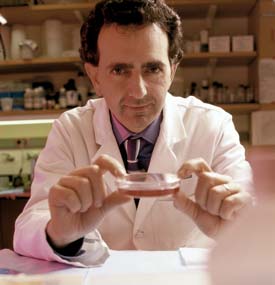Tony Atala: Artificial Bladder by Krishnendu Saha: Difference between revisions
No edit summary |
|||
| Line 3: | Line 3: | ||
==Short Biography== | ==Short Biography== | ||
Dr. Atala graduated from University of Miami with Psychology major and completed a medical degree in urology from University of Louisville. He pursued a fellowship at Harvard Medical School | Dr. Atala graduated from University of Miami with Psychology major and completed a medical degree in urology from University of Louisville. He pursued a fellowship at Children's Hospital Boston, Massachusetts (affiliated with Harvard Medical School) and started his independent career at the same institute developing artificial organs for humans. In 1999, his team has reported the successful creation and transplantation of artificial urinary bladder in beagle dogs that showed excellent functional capabilities in terms of retaining urine and normal elastic properties upto 11 months. In 2006, this procedure was reported in humans after monitoring the patients for several years. | ||
Revision as of 18:27, 8 April 2013
Anthony Atala, M.D. is Director of the Wake Forest Institute for Regenerative Medicine, and Professor and Chair of the Department of Urology at Wake Forest School of Medicine and one of the leading scientists in the fields of tissue engineering and regenerative medicine.

Short Biography
Dr. Atala graduated from University of Miami with Psychology major and completed a medical degree in urology from University of Louisville. He pursued a fellowship at Children's Hospital Boston, Massachusetts (affiliated with Harvard Medical School) and started his independent career at the same institute developing artificial organs for humans. In 1999, his team has reported the successful creation and transplantation of artificial urinary bladder in beagle dogs that showed excellent functional capabilities in terms of retaining urine and normal elastic properties upto 11 months. In 2006, this procedure was reported in humans after monitoring the patients for several years.